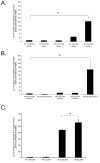Restricting dietary magnesium accelerates ectopic connective tissue mineralization in a mouse model of pseudoxanthoma elasticum (Abcc6(-/-) )
- PMID: 22897576
- PMCID: PMC3422765
- DOI: 10.1111/j.1600-0625.2012.01553.x
Restricting dietary magnesium accelerates ectopic connective tissue mineralization in a mouse model of pseudoxanthoma elasticum (Abcc6(-/-) )
Abstract
Ectopic mineralization, linked to a number of diseases, is a major cause of morbidity and mortality in humans. Pseudoxanthoma elasticum (PXE) is a heritable multisystem disorder characterized by calcium phosphate deposition in various tissues. The mineral content of diet has been suggested to modify the disease severity in PXE. The aim of this study is to explore the role of diet with reduced magnesium in modifying tissue mineralization in a mouse model of PXE. Abcc6(-/-) mice were placed on either standard rodent diet (control) or an experimental diet low in magnesium at weaning (4 weeks) and examined for mineralization in the skin and internal organs at the ages of 1.5, 2 or 6 months by computerized morphometric analysis of histopathological sections and by chemical assay of calcium and phosphate. Abcc6(-/-) mice on experimental diet demonstrated an accelerated, early-onset mineralization of connective tissues, as compared to control mice. Wild-type or heterozygous mice on experimental diet did not show evidence of mineralization up to 6 months of age. All mice on experimental diet showed decreased urinary calcium, increased urinary phosphate and elevated parathyroid serum levels. However, no difference in bone density at 6 months of age was noted. Our findings indicate that the mineral content, particularly magnesium, can modify the extent and the onset of mineralization in Abcc6(-/-) mice and suggest that dietary magnesium levels may contribute to the phenotypic variability of PXE. The control of mineralization by dietary magnesium may have broader implications in general population in the context of vascular mineralization.
© 2012 John Wiley & Sons A/S.
Conflict of interest statement
The authors have no conflict of interest.
Figures


Similar articles
-
Magnesium carbonate-containing phosphate binder prevents connective tissue mineralization in Abcc6(-/-) mice-potential for treatment of pseudoxanthoma elasticum.Clin Transl Sci. 2009 Dec;2(6):398-404. doi: 10.1111/j.1752-8062.2009.00161.x. Clin Transl Sci. 2009. PMID: 20443931 Free PMC article.
-
Ectopic mineralization of connective tissue in Abcc6-/- mice: effects of dietary modifications and a phosphate binder--a preliminary study.Exp Dermatol. 2008 Mar;17(3):203-7. doi: 10.1111/j.1600-0625.2007.00645.x. Epub 2007 Nov 2. Exp Dermatol. 2008. PMID: 17979973 Free PMC article.
-
Elevated dietary magnesium prevents connective tissue mineralization in a mouse model of pseudoxanthoma elasticum (Abcc6(-/-)).J Invest Dermatol. 2009 Jun;129(6):1388-94. doi: 10.1038/jid.2008.391. Epub 2009 Jan 1. J Invest Dermatol. 2009. PMID: 19122649 Free PMC article.
-
ABCC6, Pyrophosphate and Ectopic Calcification: Therapeutic Solutions.Int J Mol Sci. 2021 Apr 27;22(9):4555. doi: 10.3390/ijms22094555. Int J Mol Sci. 2021. PMID: 33925341 Free PMC article. Review.
-
Pseudoxanthoma elasticum: clinical phenotypes, molecular genetics and putative pathomechanisms.Exp Dermatol. 2009 Jan;18(1):1-11. doi: 10.1111/j.1600-0625.2008.00795.x. Epub 2008 Oct 22. Exp Dermatol. 2009. PMID: 19054062 Free PMC article. Review.
Cited by
-
Paediatric pseudoxanthoma elasticum with cardiovascular involvement.Br J Dermatol. 2013 Nov;169(5):1148-51. doi: 10.1111/bjd.12462. Br J Dermatol. 2013. PMID: 23746223 Free PMC article.
-
Genetic modulation of nephrocalcinosis in mouse models of ectopic mineralization: the Abcc6(tm1Jfk) and Enpp1(asj) mutant mice.Lab Invest. 2014 Jun;94(6):623-32. doi: 10.1038/labinvest.2014.52. Epub 2014 Apr 14. Lab Invest. 2014. PMID: 24732453 Free PMC article.
-
Abcc6 Knockout Rat Model Highlights the Role of Liver in PPi Homeostasis in Pseudoxanthoma Elasticum.J Invest Dermatol. 2017 May;137(5):1025-1032. doi: 10.1016/j.jid.2016.11.042. Epub 2017 Jan 19. J Invest Dermatol. 2017. PMID: 28111129 Free PMC article.
-
Phylogeny and chemistry of biological mineral transport.Bone. 2020 Dec;141:115621. doi: 10.1016/j.bone.2020.115621. Epub 2020 Aug 26. Bone. 2020. PMID: 32858255 Free PMC article. Review.
-
Mineralization/anti-mineralization networks in the skin and vascular connective tissues.Am J Pathol. 2013 Jul;183(1):10-8. doi: 10.1016/j.ajpath.2013.03.002. Epub 2013 May 8. Am J Pathol. 2013. PMID: 23665350 Free PMC article. Review.
References
-
- Touart DM, Sau P. Cutaneous deposition diseases. Part I and Part II. J Am Acad Dermatol. 1998;39:149–171. 527–544. - PubMed
-
- Köstler E, Porst H, Wollina U. Cutaneous manifestations of metabolic diseases: uncommon presentations. Clin Dermatol. 2005;23:457–464. - PubMed
-
- Budoff MJ, Shaw LJ, Liu ST, et al. Long-term prognosis associated with coronary calcification: observations from a registry of 25,253 patients. J Am Coll Cardiol. 2007;49:1860–1870. - PubMed
-
- Weenig RH, Seqell LD, Davis MD, McCarthy JT, Pittelkow MR. Calciphylaxis: natural history, risk factor analysis, and outcome. J Am Acad Dermatol. 2007;56:569–579. - PubMed
Publication types
MeSH terms
Substances
Grants and funding
LinkOut - more resources
Full Text Sources
Medical

